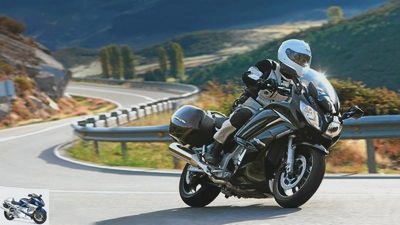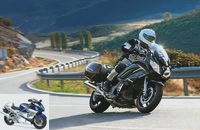Menus

Manufacturer
The Yamaha tourer in a new outfit 2013
Already driven: Yamaha FJR 1300
No question about it, many had settled for a brand new FJR 1300. And what is Yamaha setting us up? An old friend in a new outfit. But sometimes such a rejuvenation treatment works wonders.
There are compliments that are only given behind closed doors. “But it has held up well” is part of it, because it clearly speaks to the expiry date. Nobody likes to talk about that. Except for Yamaha. “When we introduced the FJR 1300 in 2001, we gave the touring segment a new dynamic,” is the reliable first sentence of an FJR presentation. It is exactly the same, the Yamaha strategists are right and still fondly remember it today at every opportunity. What you sometimes have to remind them of, however, is the time dimension. “Hello, that was over a decade ago,” you want to call out to them. “A lot has happened in the meantime.”
GEnau, it has. A Kawasaki GTR 1400 came, the BMWs K 1200 GT and K 1300 GT came and went, a six-cylinder from Munich flooded the scene with power, torque and electronic fireworks. Only the FJR remained as it was. At least in its foundations. This has not changed in the 2013 model year either. “Why should I?” You ask at Yamaha. “What can others do that the FJR cannot?”
Buy complete article

The Yamaha tourer in a new outfit 2013
Already driven: Yamaha FJR 1300
Yamaha has finally managed to keep your fingers warm without the coarse throttle grip and dangling cables. And on the other hand, because this FJR function – like many others – can be controlled centrally from the left handlebar end. A menu button, a rocker switch – that’s all it takes to activate the three-stage heated grips. Or the height of the new, more expansive windshield. Or the new functions of the digital display, in which everything from the outside temperature to the average consumption, the actual driving time or the average speed can be clearly viewed.
Yamaha
Even power delivery, good handling, stable chassis – that was and is the FJR.
That is progress, no question about it, given the rather rudimentary information content of the predecessor. And it corresponds to contemporary touring standards. The same applies to the new, standard cruise control, which can be operated intuitively from the left end of the handlebar and which varies the speed in two-kilometer steps at the push of a button. The position of the wider, higher and now differently rear-flow windscreen can be adjusted continuously. There is also now a memory function so that you don’t have to readjust it after each stop. The wind protection is undoubtedly better than before, even if it is still a big step to calm behind a K 1600 or even Pan European pane.
But at Yamaha they deliberately don’t want to go, as is emphasized again and again in the Spanish mountains. On the contrary: with the stable chassis, the powerful engine, the clear dimensions and the low weight for the touring class (298 kilograms with a full tank) you have just the pound that you can grow with. From this point of view, it is only logical that Yamaha stuck to the benchmarks and only optimized them in detail. In mixture preparation, for example, where computer-controlled servomotors now open the throttle valves instead of the sensitive throttle hand, and do so to perfection. Soft, but certain throttle response, jerk-free acceleration, emphatic thrust over the entire speed range – in this regard there is really nothing to complain about with the new one, especially since the 1300s in the facelift, especially thanks to new, more effective catalytic converters (now two instead of four) mobilized almost three hp more power.
Yamaha
New and clear: the central speedometer with a huge speed display, next to it the info display with gear display and all additional functions.
But that was only of secondary importance, because the FJR is still well positioned in terms of performance. Rather, the primary goal was to install traction control and two different mapping variants. “S” opens the throttle valve much wider than the tamer “T-mode”, which is actually not needed in view of the impeccable manners of the S variant. Neither does the traction control (which can be switched off). At least on the gourmet asphalt in the Spanish hinterland, while it certainly does a good job in the rain or on loose terrain. Under these conditions, one is also happy about the ABS, which has been adopted unchanged and reliably, but still does its job with somewhat coarse control frequencies. However, if you want to slow down hard, you should always use the foot brake lever, because with the partially integrated Yamaha system only then is the combined braking force available at the front, while the rear brake remains outside when the brake lever is pulled.
Yamaha
Reorganized: All important functions can be controlled centrally from the left end of the handlebar.
But only by the way. What are the most important innovations, the electrically adjustable chassis and the second generation of the clutch-free YCC-S transmission? Unfortunately, both will only be available in the AS version in spring, and only as a package. Until then, those interested in FJR will have to make do with the revised basic chassis, which has been tuned a little tighter (see right) and has received new tires (Bridgestone BT023 or, as in the model that was driven, Metzeler Roadtec Z8 Interact). But this is also the only modification of the new FJR that is not completely convincing, because – at least that was the impression made during the driving appointment in Spain – some feedback and neutrality fell by the wayside, because the FJR was noticeable by bumps in the sloping position off course. However, only a detailed test can provide final information.
Until then, potential FJR new customers and FJR owners (95,000 FJRs have been sold worldwide) should think about stopping by the friendly Yamaha dealer in view of the unchanged price of 17,395 euros. Or better: whether you really need more than the FJR 1300 offers, because it has indeed held up well. In any case, hardly anyone missed anything during the two entertaining days in the hinterland of Madrid. Not even sixth gear or overdrive, because longer stretches of the motorway were not on the presentation route.
Technical data / What’s new?
Yamaha
Elegant: The new brown looks good on the FJR, as does the new lines.
engine
Water-cooled four-cylinder four-stroke in-line engine, two balancer shafts, two overhead, chain-driven camshafts, four valves per cylinder, bucket tappets, wet sump lubrication, injection, ø 42 mm, regulated catalytic converter with secondary air system, 490 W alternator, 12 V / 12 Ah battery, hydraulically operated multiple discs -Oil bath clutch, five-speed gearbox, cardan, secondary gear ratio 2.773.
Bore x stroke 79.0 x 66.2 mm
Cubic capacity 1298 cm³
Compression ratio 10.8: 1
rated capacity 107.5 kW (146 hp) at 8000 rpm
Max. Torque 138 Nm at 7000 rpm
landing gear
Bridge frame made of aluminum, telescopic fork, ø 48 mm, adjustable spring base, rebound and compression damping, two-arm swing arm made of aluminum, central spring strut with lever system, adjustable spring base and rebound damping, double disc brake at the front, ø 320 mm, four-piston fixed calipers, disc brake at the rear, ø 282 mm, double piston – Floating caliper, partially integral brake system with ABS.
Cast aluminum wheels 3.50 x 17; 5.50 x 17
Tires 120/70 ZR 17; 180/55 ZR 17
Dimensions + weights
Wheelbase 1545 mm, steering head angle 64.0 degrees, caster 109 mm, spring travel f / h 135/125 mm, weight with a full tank of 289 kg, tank capacity 25.0 liters.
Two year guarantee
Colors brown, black, silver
price 17 395 euros
Additional costs 230 euros
What‘s new?
- Ride-by-Wire (YCC-T)
- Traction control (TCS)
- Cruise control
- Two driving modes (sport and touring)
- More power (just under three hp)
- Revised fork (progressive springs / firmer damping)
- Revised shock absorber (higher spring rate / tighter damping)
- New cockpit, changed operating concept
- New front section with improved wind protection and faster adjustment mechanism
Related articles
-
Yamaha 15 pictures Yamaha 1/15 … in which the V4 is screwed in four places and has a supporting function. Yamaha 2/15 Yamaha’s new Vmax is a …
-
Driving report Yamaha WR 250-450 F
Driving report Yamaha WR 250/450 F Full pack What is good for the crossers, can’t hurt for the hard enduros. That’s why MOTORRAD plowed with the …
-
Yamaha MT-10 in the driving report
markus-jahn.com 15 pictures markus-jahn.com 1/15 The Yamaha MT-10 is based closely on the R1 with its fantastic chassis. Yamaha 2/15 Sporty …
-
Driving report Yamaha XT 1200 ZE Super Tenere
Gargolov 26 pictures Gargolov 1/26 Gargolov 2/26 Gargolov 3/26 Gargolov 4/26 Gargolov 5/26 Gargolov 6/26 Gargolov 7/26 Gargolov 8/26 Gargolov 9/26 Gargolov …
-
Driving report: Yamaha XT 1200 Z Super Tenere
Mayer 23 pictures Yamaha 1/23 The wheel speed sensors for ABS and traction control receive their signals from radially attached rings. Yamaha …
-
fact driving report Yamaha MT-03 Kodo, the third … in this case does not come from the center of the stars, but from Italy. The MT-03 is used at …
-
Yamaha MT-10 in the HP driving report
markus-jahn.com 13 pictures markus-jahn.com 1/13 Yamaha MT-10. markus-jahn.com 2/13 Yamaha MT-10. markus-jahn.com 3/13 The Yamaha MT-10 is now ready …
-
Jahn driving report Yamaha MT-01 life between 2 and 3 More than 3000 revolutions are actually required for speedy cornering on the new Yamaha …
-
Comparison test Honda CB 1300 S, Suzuki Bandit 1200 S, Yamaha FZ1 Fazer
Bilski comparison test Honda CB 1300 S, Suzuki Bandit 1200 S, Yamaha FZ1 Fazer search for traces They have sporty roots in common. At the Honda in …
-
Driving report: Yamaha FZ8 – Fazer 8
Yamaha driving report middle class: Yamaha Yamaha FZ8 / Fazer 8 It is not long until it hits eight in the Yamaha middle class range. In June…